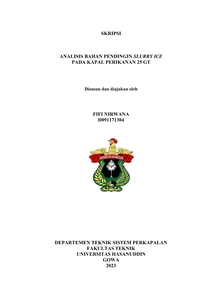Nirwana, Fifi (2023) ANALISIS BAHAN PENDINGIN SLURRY ICE PADA KAPAL PERIKANAN 25 GT = Slurry ice Coolant Analysis on a Fishing Vessels 25 GT. Skripsi thesis, Universitas Hasanuddin.
![[thumbnail of Cover]](/27875/1.hassmallThumbnailVersion/D091171304_skripsi_24-05-2023%20cover1.jpg)

D091171304_skripsi_24-05-2023 cover1.jpg
Download (214kB) | Preview
D091171304_skripsi_24-05-2023 bab 1-3.pdf
Download (561kB)
D091171304_skripsi_24-05-2023 dp.pdf
Download (577kB)
D091171304_skripsi_24-05-2023.pdf
Restricted to Repository staff only until 1 September 2025.
Download (1MB)
Abstract (Abstrak)
Bahan pendingin merupakan salah satu hal penting karena kualitas hasil ikan bergantung pada kemampuan bahan pendingin. Semakin rendah suhu bahan pendingin semakin baik dalam menjaga kualitas ikan. Bahan pendingin yang umunya digunakan yaitu es balok, tetapi es balok memiliki kekurangan yaitu bentuk es balok yang memiliki sisi tajam yang dapat menimbulkan luka pada ikan yang dapat menurunkan kualitas ikan. Es balok juga sebagian mencair selama perjalanan menuju tempat penangkapan ikan. Salah satu upaya untuk mengatasi masalah tersebut adalah dengan menggunakan slurry ice. Slurry ice tidak memiliki sisi tajam sehingga mengurangi resiko timbulnya luka pada hasil tangkapan dan slurry ice dapat diproduksi diatas kapal. Dalam penelitian ini dilakukan analisis bahan pendingin pada kapal perikanan 25 GT, penelitian ini dilakukan untuk mengetahui jumlah bahan pendingin slurry ice jika dibandingkan dengan es balok, dan kelayakan ekonomis jika menggunakan bahan pendingin slurry ice. Metode yang digunakan dalam penelitian ini menggunakan rumus empiris. Hasilnya menunjukkan jumlah bahan pendingin slurry ice dan es balok dengan kapasitas palka yang sama dalam satu kali trip yaitu berturut-turut 417,667 kg dan 421,450 kg. Berdasarkan analisis ekonomis dengan nilai NPV = 90.2917.623 dan payback periode adalah 6 bulan waktu pengembalian modal awal dengan menggunakan bahan pendingin slurry ice, maka sistem pendingin ikan dengan bahan pendingin slurry ice dikatakan layak.
Coolant is one of the important things because the quality of fish results depends on the ability of the coolant. The lower the temperature of the cooling material the better it is in maintaining the quality of the fish. The cooling material that is generally used is ice cubes, but ice blocks have drawbacks, namely the shape of ice blocks that have sharp edges which can cause injuries to fish which can reduce the quality of fish. The ice blocks also partially melted during the journey to the fishing grounds. One effort to overcome this problem is to use slurry ice. Slurry ice has no sharp edges thereby reducing the risk of injury to fish and slurry ice can be produced on board. In this research, an analysis of coolant was carried out on a 25 GT fishing vessel. This research was conducted to determine the amount of slurry ice coolant when compared to block ice, and the economic feasibility of using slurry ice coolant. The method used in this study uses an empirical formula. The results show the amount of coolant for slurry ice and block ice with the same hold capacity in one trip, that is 417,667 kg and 421,450 kg respectively. Based on economic analysis with NPV = 90,2917,623 and payback period is 6 months, the initial payback period using slurry ice cooling material, the fish cooling system with slurry ice cooling material is said to be feasible.
Keywords : Sistem pendingin, Kapal Perikanan, Slurry ice.
| Item Type: | Thesis (Skripsi) |
|---|---|
| Uncontrolled Keywords: | Cooling system, Fishing vessels, Slurry ice |
| Subjects: | T Technology > T Technology (General) |
| Divisions (Program Studi): | Fakultas Teknik > Teknik Sistem Perkapalan |
| Depositing User: | S.Sos Rasman - |
| Date Deposited: | 27 Sep 2023 00:25 |
| Last Modified: | 27 Sep 2023 00:25 |
| URI: | http://repository.unhas.ac.id:443/id/eprint/27875 |


